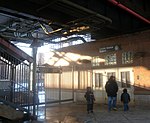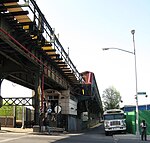Marcus Garvey Village
Marcus Garvey Village, also known as Marcus Garvey Apartments, is a 625-unit affordable housing development located in the Brownsville neighborhood of Brooklyn. The complex was developed by the New York State Urban Development Corporation and designed by British architect Kenneth Frampton (then at the Institute for Architecture and Urban Studies) in 1973 and completed in 1976. The master plan and buildings were later redesigned by Michael Kirchmann of GDSNY for a substantial renovation in 2016. It consists of multiple four-story townhouse-like structures spread across nine city blocks with stoops, private backyards, and semi-public courtyards.It was one of the first low-rise, high-density public housing projects and was included in a 1973 Museum of Modern Art exhibition titled Another Chance for Housing: Lowrise Alternatives. The complex was named after Jamaican politician and activist Marcus Garvey.
Excerpt from the Wikipedia article Marcus Garvey Village (License: CC BY-SA 3.0, Authors).Marcus Garvey Village
Chester Street, New York Brooklyn
Geographical coordinates (GPS) Address Nearby Places Show on map
Geographical coordinates (GPS)
| Latitude | Longitude |
|---|---|
| N 40.66321 ° | E -73.90985 ° |
Address
Chester Street 351
11212 New York, Brooklyn
New York, United States
Open on Google Maps









